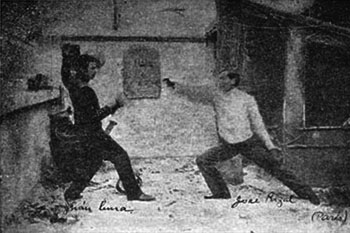I took up the study of sport fencing in the early 1990s under Socorro Olivan. Besides being a fencing instructor, Olivan was also a blackbelt karateka and a champion judo player. With a couple of years of arnis-escrima training behind me, it took some times before I developed finesse in my movements in accordance with the body mechanics of western fencing. I remember Olivan reprimanding me a number of times for nearly breaking the frangible foil blade.
As an escrimador who favored largo mano style of fighting, my training in western fencing served me well. The largo mano (long hand) style is among the simplest and most potent system of arnis-escrima. As its name implies, largo mano is a long-range style utilizing distance, evasion and the sneaky delivery of strikes.
One common thread evident in western fencing (particularly those employing the foil and the epee) and largo mano is the mental orientation among its players that the tip (the last three inches) of the weapon is the one that inflicts the damage. Largo mano fighters recognize the fact that the stick is first and foremost an impact weapon and it would pay well to utilize its long-range capability. The stick used in largo mano is about 30 inches, considerably longer than common escrima sticks.
Like in western fencing, accuracy is paramount in largo mano fighting. Hits should land with surgical precision on vital areas. Using the length of the weapon to his advantage, a largo mano fighter avoids stick-to-stick contact during a skirmish and attempts to hit the opponent’s weapon hand instead. The fast and economical footwork of western fencing is very useful in maintaining the optimal fighting range in largo mano. Whenever possible, a largo mano stylist uses footwork and evasive body movements to avoid blows instead of blocking.

Jose Rizal (right) and Juan Luna (left) practicing fencing in Paris. Juan Luna is the painter brother of General Antonio Luna.
Again, like in western fencing, another apparent feature of largo mano is the nearly total absence of the use of the “alive hand” or non-weapon hand. The “alive hand” is used for trapping and disarms in arnis-escrima at close quarters. This is understandable since a largo mano fighter, given sufficient room, would always opt to fight long-range. So, if an escrimador can’t reach his opponent with his non-weapon hand, he knows he is within the largo mano range. Given the kind of speed possible with the stick or blade in this range, it is rather foolhardy to try to grab your opponent’s weapon hand with your alive hand. In western fencing, the non-weapon hands often acts as a counterbalance to the sword hand while executing lunging thrusts.
The most renowned master of the largo mano style is the late Leovigildo “Leo” Giron. Giron, along with the late Master Angel Cabales and Master Max Sarmiento holds the distinction of being the very first to openly teach arnis-escrima in the United States. Giron had used his art in jungle warfare as a soldier of the US Army in the Philippines during World War II. Using the bolo as his primary weapon, Giron’s largo mano skill proved useful when he walked as the lead man of guerillas patrolling through Philippine forests during that war. His task was to disable Japanese soldiers first with his blade and let those walking behind him finish the job. He was awarded a number of medals for bravery during those guerilla operations.
The influences of western fencing most probably made its way to the native FMA during the rise of the Ilustrado class during the Spanish colonial period. Ilustrado, which is a Spanish word for “erudite” pertains to the middle class or educated Filipinos during that period. A good case in point is the Philippines’ national hero Dr. Jose Rizal who was both an adept in western fencing and arnis. Rizal taught arnis to young boys during his exile in Dapitan.
Because they have the money to study abroad, members of the Ilustrado class were exposed to the occidental ways of warfare. One contemporary of Rizal who was also known for his fighting prowess and his role in the revolution against Spain was General Antonio Luna. Like Rizal, Luna was also an excellent marksman and swordsman. Rey Resurrection, in an article titled “Wizard in the War” published in “Filipino Heritage,” tells of an interesting facet of Luna’s education, it reads, “In Spain, Luna went into an earnest study of war. He majored in military organization, strategy and tactics. He never intended to take up a soldier’s career [he was originally trained as a pharmacist], but he has the blood of warriors in his veins – five uncles in his mother’s side were officers in the Spanish Army – and it was not surprising that he followed their footsteps.” Another part of the article says, “As soon as he was allowed to leave Spain he proceeded to Ghent, Belgium, where he took up the study of guerilla warfare with General Leman, who was to become the hero of the Battle Of Liege in World War I.”
It was interesting to note that Rizal nearly fought Luna in a duel in Spain because of the latter’s unsavory remarks against his love interest Nellie Boustead. Realizing that the interest of the revolution would be compromised, the duel was aborted when Luna apologized and when the Filipinos in Madrid intervened.
The influence of western swordsmanship was evident in the names of some systems of FMA. One good example is “estocada,” which was derived from the word “estoc,” a French sword designed for piercing chain mail.





















